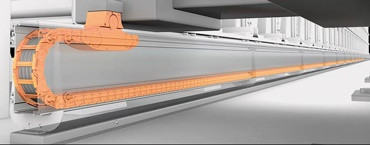How electric sliding gates become more reliable
pwirth | 11. October 2021
Defects on electric sliding gates are annoying. They waste time and generate costs – for example when lorries can no longer enter the company premises. microflizz – an energy supply system from igus that has won the iF Design Award – ensures greater reliability. In this post, I’ll show you the benefits of the system.
I lived in a housing estate in Cologne. Underground parking was included. Although a luxury, it was always a nuisance. Because, without exaggeration, the garage’s roller shutter was out of order about four months a year over the years. It just stayed open. Technicians took weeks to arrive. An invitation to thieves. Two motorcycles were stolen.
But enough whining now. Better to think about the positives. So what ways can we increase the reliability of sliding gates? Our answer starts with energy supply system. In order to guide cables for energy and data in gate systems over lengths of up to 100 metres in a fail-safe manner, we have developed microflizz – an iF Design award-winning energy supply system that comprises three components: Cables from the chainflex series, an energy chain made of high-performance plastic and an aluminium enclosure. What advantages does the system offer? Several, which I will present below.
microflizz defies wind and weather
Wind, rain, snow and frost are constant adversaries of sliding gates. If sensitive components corrode, failure is not far away. We have therefore designed microflizz in such a way that the system works reliably in harsh environmental conditions. The choice of suitable materials was easily decided. The cables for energy and data are inserted in e-chains made of high-performance plastic – a material that is corrosion-free and works reliably even in high humidity and frost. The enclosure of the e-chain is also unaffected by the weather. It is made of anodised aluminium and is closed on three sides to protect the e-chain from dirt and dust.
Design refinement reduces wear of the energy chains
Sliding gates move constantly – often day and night, 365 days a year. Components are exposed to permanent load. Accordingly, it is important that components are wear-resistant. To achieve this, our designers came up with a refinement: they integrated side wings with a spring element into the links of the e-chain. When stretched, they hold the chain securely in a groove in the upper and lower part of the aluminium enclosure. If the chain bends, the wings fold in automatically. This allows the energy chain to leave the groove and settle down freely.
Why does this increase the wear resistance? Because the upper and lower runs of the e-chain do not have to rest on each other to guarantee safe operation. Thanks to the microflizz housing, this reliable operation is contactless. And when components don’t touch, they wear less. Logical. Sliding gates are therefore more durable. Also logical. This is also proven by tests in the in-house igus laboratory that sprawls across an area of 2,700m2. Even after one million double strokes and a covered distance of over 6,000 kilometres, there was virtually no wear visible on the energy chain of the microflizz system. Equally robust are the cables of the chainflex series, on which we give an above-average guarantee of 36 months.
Users save energy
The microflizz not only makes the sliding gates more reliable. Users also benefit from many other advantages. This is how they save energy. Why? Because the upper and lower runs of the e-chain do not touch and therefore hardly any frictional forces are generated. And less friction means reduced drive power. And thus decreasing energy consumption.
In addition, the system saves installation space. The MF06 series enclosure can be installed horizontally or vertically as it is only 108.48mm high and 29.5mm wide. In addition to energy cables, the e-chains can also accommodate hoses and chainflex fibre optic cables with data rates of up to 10GBit/s. By means of a reverse arrangement, even two e-chains can run simultaneously in one guide channel. This flexibility is another reason why microflizz can be found in more and more sliding gates worldwide. A nice application example is an aircraft hangar, where the microflizz is already performing its services.
And what are your experiences with sliding gates? What do you think is the Achilles heel? What needs to be improved? We look forward to your comments!


